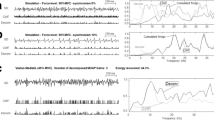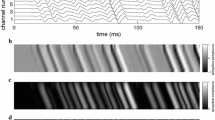Abstract
A technique is proposed that allows automatic decomposition of electromyographic (EMG) signals into their constituent motor unit action potential trains (MUAPTs). A specific iterative algorithm with a classification method using fuzzy-logic techniques was developed. The proposed classification method takes into account imprecise information, such as waveform instability and irregular firing patterns, that is often encountered in EMG signals. Classification features were determined by the combining of time position and waveform information. Statistical analysis of inter-pulse intervals and spike amplitude provided an accurate estimation of features used in the classification step. Algorithm performance was evaluated using simulated EMG signals composed of up to six different discharging motor units corrupted with white noise. The algorithm was then applied to real signals recorded by a high spatial resolution surface EMG device based on a Laplacian spatial filter. On six groups of 20 simulated signals, the decomposition algorithm performed with a maximum and an average mean error rate of 2.13% and 1.37%, respectively. On real surface EMG signals recorded at different force levels (from 10% to 40% of the maximum voluntary contraction), the algorithm correctly identified 21 MUAPTs, compared with the 29 MUAPTs identified by an experienced neurophysiologist. The efficiency of the decomposition on surface EMG signals makes this method very attractive for non-invasive investigation of physiological muscle properties. However, it can also be used to decompose intramuscularly recorded EMG signals.
Similar content being viewed by others
References
Basmajian, J. V., andDe Luca, C. J. (1985): ‘Muscle alive. Their function revealed by electromyography’ (Williams & Wilkins, Baltimore, USA, 1985)
Christodoulou, C. I., andPattichis, C. S. (1999): ‘Unsupervised pattern recognition for the classification of EMG signals’,IEEE Trans. Biomed. Eng.,46, pp. 169–178
Duchêne, J., andHogrel, J. Y. (2000): ‘A model of EMG Generation’,IEEE Trans. Biomed. Eng.,47, pp. 192–201
Fang, J., Agarwal, G. C., andShahani, B. T. (1999): ‘Decomposition of multiunit electromyographic signals’,IEEE Trans. Biomed. Eng.,46, pp. 685–696
Hogrel, J.-Y., andDuchene, J. (1999): ‘A SEMG-based system for clinical applications using laplacian electrodes’, inHermens, H. J., andFreriks, B. (Eds). ‘Future applications of surface electromyography, SENIAM 4’ (Roessingh Research and Development b.v., Enschede), pp. 172–177
Iani, C., Stålberg, E., Falck, B., andBishoff, C. (1994): ‘New approaches to motor unit potential analysis’,Ital. J. Neurol. Sci.,15, pp. 447–459
Lefever, R. S., andDe Luca, C. J. (1982a): ‘A procedure for decomposing the myoelectric signal into its constituent action potentials-Part I: Technique, theory, and implementation’,IEEE Trans. Biomed. Eng.,29, pp. 149–157
Lefever, R. S., andDe Luca, C. J. (1982b): ‘A procedure for decomposing the myoelectric signal into its constitutent action potentials-Part II: Execution and test for accuracy’,IEEE Trans. Biomed. Eng.,29, pp. 158–164
Mamdani, E. H., andAssilian, S. (1975): ‘An experiment in linguistic synthesis with a fuzzy logic controller’,Int. J. Man-Mach. Stud.,7, pp. 1–13
McGill, K., Cummins, K. L., andDorfman, L. J. (1985): ‘Automatic decomposition of the clinical electromyogram’,IEEE Trans. Biomed. Eng.,32, pp. 470–477
Rau, G., andDisselhorst-Klug, C. (1997): ‘Principles of highspatial-resolution surface EMG (HSR-EMG): single motor unit detection and application in the diagnosis of neuromuscular disorders’,J. Electromyogr. Kinesiol.,7, pp. 233–239
Reucher, H., Rau, G., andSilny, J. (1987a): ‘Spatial filtering of noninvasive multielectrode EMG: Part I—Introduction to measuring technique and applications’,IEEE Trans. Biomed. Eng.,34, pp. 98–105
Reucher, H., Silny, J., andRau, G. (1987b): ‘Spatial filtering of noninvasive multielectrode EMG: Part II—Filter performance in theory and modelling’,IEEE Trans. Biomed. Eng.,34, pp. 106–113
Roeleveld, K., Stegeman, D. F., Falck, B., andStålberg, E. V. (1997): ‘Motor unit size estimation: confrontation of surface EMG with macro EMG’,Electroencephalogr: Clin. Neurophysiol.,105, pp. 181–188
Stashuk, D. W., andQu, Y. (1996a): ‘Adaptive motor unit action potential clustering using shape and temporal information’,Med. Biol. Eng. Comput.,34, pp. 41–49
Stashuk, D. W., andQu, Y. (1996b): ‘Robust method for estimating motor unit firing-pattern statistics’,Med. Biol. Eng. Comput.,34, pp. 50–57
Stashuk, D. W. (1999): ‘Decomposition and quantitative analysis of clinical electromyographic signals’,Med. Eng. Phys.,21, pp. 389–404
Stashuk, D. W. (2001): ‘EMG signal decomposition: how can it be accomplished and used?’,J. Electromyogr. Kinesiol.,11, pp. 151–173
Takagi, T., andSugeno, M. (1985): ‘Fuzzy identification of systems and its application to modelling and control’,IEEE Trans. Syst. Man Cybern.,15, pp. 116–132
Zadeh, L. A. (1965): ‘Fuzzy sets’,Inf. Control,8, pp. 338–353
Zadeh, L. A. (1978): ‘Fuzzy sets as a basis for a theory of possibility’,Fuzzy Set Syst.,1, pp. 3–28
Author information
Authors and Affiliations
Rights and permissions
About this article
Cite this article
Chauvet, E., Fokapu, O., Hogrel, J.Y. et al. Automatic identification of motor unit action potential trains from electromyographic signals using fuzzy techniques. Med. Biol. Eng. Comput. 41, 646–653 (2003). https://doi.org/10.1007/BF02349972
Received:
Accepted:
Issue Date:
DOI: https://doi.org/10.1007/BF02349972




